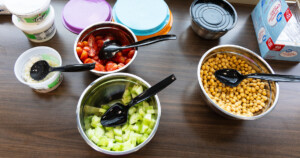February is National Heart Month! This is a great opportunity for education about food labels and becoming more aware of the dangers of sodium and saturated fat in our diets, as well as the importance of dietary fiber and exercise. Our dietitians from the Mind-Body Wellness Center explain some nutritional best practices for our heart health.
Reduce Saturated Fat and Sodium
Stefanie Arblaster, RD, LDN

Saturated fat is a type of fat that mainly comes from animal sources (meats, full-fat dairy) and packaged foods (frozen TV dinners, packaged deserts, etc.). High intakes of this type of fat have been shown to increase LDL cholesterol (AKA “bad” cholesterol) and risk of cardiovascular conditions. The American Heart Association recommends no more than 5-6% of total daily calories from saturated fat.
Tips to reduce saturated fat, incorporate more of the following into your diet:
- lean protein sources such as chicken, turkey, tuna, 90/10 beef, etc.
- fish such as salmon, tilapia, cod, etc.
- meatless meals that highlight protein sources from nuts/seeds, tofu, beans/legumes, etc.
It’s also important to prepare meals with plant oils (olive oil, canola oil, avocado oil) in place of butter when trying to limit saturated fat.

Sodium is present in many foods throughout the traditional American diet, such as frozen dinners, pre-packaged snacks, and restaurant/fast food meals. We also get sodium from adding salt to foods in the cooking process. We do need sodium in our diet to help maintain fluid and electrolytes, however excessive amounts can lead to high blood pressure and increased risk of cardiovascular complications. The American Heart Association recommends no more than 2,300 mg sodium of per day.
In order to reduce sodium in the diet, start by cooking most meals at home. As stated prior, fast food chains and restaurant foods have a lot of sodium added to them in order to promote flavor and to preserve the food in storage. Cooking at home will allow you to have more control over the sodium in your meals. To put this into perspective, a meal consisting of a McDonald’s cheeseburger, a medium fry, and a small coke has approximately 1,020 mg of sodium (based on the nutrition calculator from McDonald’s website). This is almost half of what the American Heart Association recommends per day in just one meal!
In place of salt, experiment with seasonings such as pepper, garlic/onion powder, paprika, cumin, red pepper flakes, etc. This will help improve flavor of your foods while working to reduce overall sodium consumption. Another good option to add to your pantry for cooking meals at home would be reduced or low-sodium shelf-stable products such as chicken broth, canned vegetables, tuna, etc.
Increase Your Fiber Intake and Physical Activity
Bethany Say, RD, LDN, CDCES

One final thought about sodium: if people are looking for a sodium “budget” per meal, I suggest aiming for about 600 mg. If they hit that for all three meals, that’s about 1800 mg and leaves some wiggle room for snacks and drinks that may have some sodium in them, until you reach that daily allotment of 2300 mg. If you are at times closer to 800 mg per meal (say with something like a frozen meal), I’d suggest balancing that with lower sodium foods at other meals that day, which could be with a variety of fruits, vegetables, and light dairy products. When possible, try to spread out your sodium intake throughout the day if possible, since it’s easier on your body than having it all at once.
Reducing saturated fat and sodium are great nutritional guidelines, and one thing you can definitely add instead of reducing for heart and overall health is more fiber! Fiber can be obtained through whole grains, fruits, and vegetables. When we eat fiber, bile attaches itself to the fiber. The body then needs to use cholesterol in order to make more bile, thus helping decrease cholesterol levels in the body. Here are some examples of good sources of fiber:
- Whole grains include oatmeal, whole grain bread, brown rice, whole grain pasta, barley, and popcorn
- Fresh or frozen fruit, and if you’re using canned fruit or fruit cups, look for options that are packed in 100% juice or light syrup
- Fresh or frozen vegetables are also great options. Choose frozen vegetables that do not have seasonings or sauces already on them, as they are often high in sodium. Instead, you can grab some Mrs. Dash seasonings and some light butter to flavor them yourself. If using canned vegetables, look for no salt added or low sodium if possible. Rinsing canned vegetables can reduce the sodium content by 40%.
- Ground flax seeds are a great additive to help decrease cholesterol levels. It can be added to smoothies, yogurt parfaits, homemade breads, oatmeal, or protein energy balls.

Exercise is a part of a good nutritional plan, and being regularly active supports a happy healthy heart too! The American Heart Association (AHA) recommends working your way up to at least 150 minutes per week of moderate-intensity aerobic activity or 75 minutes per week of vigorous aerobic activity, or a combination of both, preferably spread throughout the week. Start as small and slow as you need to for your exercise regimen to become a habit (see January’s wellness post about setting goals!). The AHA recommends walking as a good starting place for most people. Chair exercises are a great option for those with mobility issues!
Examples for moderate intensity exercise:
- brisk walking (at least 2.5 miles per hour)
- water aerobics
- dancing (ballroom or social)
- gardening
- tennis (doubles)
- biking slower than 10 miles per hour
Examples for rigorous intensity:
- hiking uphill or with a heavy backpack
- running
- swimming laps
- vigorous aerobic dancing
- heavy yardwork such as continuous digging or hoeing
- tennis (singles)
- cycling 10 miles per hour or faster
- jumping rope
Also consider adding moderate to high intensity muscle-strengthening activity (such as resistance or weights) on at least 2 days per week. Remember to spend less time sitting too! That’s a hard one for office workers, but even light intensity activity can offset some of the risks of being sedentary. Gain even more benefits by being active at least 300 minutes (5 hours) per week and increase amount and intensity gradually over time to build a strong foundation for your nutritional habits!
Heart Month Takeaways
Now is a good time to begin evaluating nutritional labels on packaged foods for a better understanding of saturated fats and sodium levels. Too much of these is bad for your heart and overall health. Remember that on a daily basis, consume no more than 5-6% of total daily calories from saturated fat and no more than 2300 mg of sodium. Try to not have one really sodium-heavy meal, even if you’re well under the daily allotment. Too much sodium at one time is still hard on your body.
While working on decreasing or maintaining or levels or saturated fats and sodium, increase your daily intake of fiber as well as your physical activity! Bethany Say also recommends checking out YouTube for some fun workouts (Zumba class, anyone?) but does caution to stay within the boundaries of what is physically appropriate for your level of health — in other words, don’t overexert yourself!
For some ideas for heart healthy meals and snacks, check out some of these recommended recipes and links!
Heart Healthy Recipe Collections
- American Heart Association Recipe Hub: https://recipes.heart.org/en/
- Mayo Clinic collection of heart healthy recipes: https://www.mayoclinic.org/healthy-lifestyle/recipes/heart-healthy-recipes/rcs-20077163






